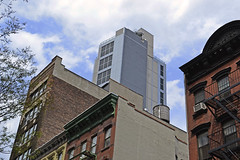It would be a gross understatement to say that the East Village is in the midst of a transition. Old buildings have been threatened and new ones are scheduled to rise, much to the chagrin of many locals. But as Bill Millard, an East Village resident and freelance writer for various architectural and urban design publications, points out in an e-mail, it’s just as “important to consider ways to encourage the types of development that provide or foster benefits for a neighborhood” as it is to protest and block “destructive forms of development.”
So what kind of development is positive and why, recently, have some seemingly less favorable projects been allowed to continue in the East Village? The Local caught up with Anne Guiney, executive director of the Institute for Urban Design, and asked for her thoughts.
What architectural elements characterized the East Village before the gentrification of the neighborhood?
It all depends on what your carbon dating system is for gentrification and how you define it. I think the East Village has, for a very long time, been defined by tenements in terms of building type. And that hasn’t changed a lot architecturally. Obviously the street-level retail and the kinds of uses are a lot more commercial, a lot more recreational than they were 20 or 30 years ago, but the physical structure of the buildings is still defined by the tenement.
What has changed recently in terms of urban planning theory in New York?
Under the Bloomberg administration, the Department of City Planning has been very proactive in terms of looking at individual neighborhoods and trying to make the zoning fit more closely with the current uses, needs, and concerns of residents and commercial tenants. I think the general policy of increasing density on avenues and maintaining a lower density on the streets is something that has changed the face of the East Village. A lot more tall buildings and condo buildings are happening on the avenues. And that is one way of trying to maintain the physical fabric that people are so familiar with while bringing more people—more traffic, more desire for services, and more money—into the wider avenues where questions of light and traffic are more easily addressed.
 Mark Riffee Ms. Guiney believes towers will continue to rise on the wide avenues while the architecture of the streets remains largely the same.
Mark Riffee Ms. Guiney believes towers will continue to rise on the wide avenues while the architecture of the streets remains largely the same.Many recently completed and proposed projects, especially surrounding the Bowery, have been met with strong community opposition and yet the projects have continued. Ideally, the neighborhood belongs to the people and their opinions are central in the planning process. Is this an unrealistic expectation?
In a place like New York City, a community is often an elastic concept and the idea of a neighborhood as belonging to the people is a fraught one—who are the people in question? On an individual level, I find myself fighting against nostalgia. You can’t be nostalgic in a place like New York. If you are, you become ossified. But market forces should not be the sole determinant of what happens in a neighborhood. There’s a middle ground.
How do you identify which projects are appropriate to protest versus where community-driven modification would be wiser in the long run?
I don’t think the starting point should be “how to stop a project.” I think you have to look much more critically at each project. The most important thing is to be smart about where your points of leverage are. You need to articulate the potential problems to your neighbors and to the members of your own community and be able to say, “We think it’s going to have X, Y, and Z economic, physical, and traffic ramifications.”
What do you think the East Village will look like in 20 years?
If you look at the changes that have happened in the East Village in the last ten years, it’s only pretty recently that they’ve started to be physical. Before that, it was demographic and economic and sort of retail-option changes. Now, the new development is starting to physically change the neighborhood. And I think that will keep on happening. I think you will have more towers and I think that most of them will probably be on the broader avenues.
Ms. Guiney and the Institute for Urban Design are currently preparing for Urban Design Week, a public forum meant to encourage community involvement in city planning that will take place in September.




